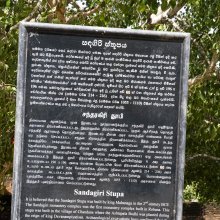Sammata, Saṃmata: 23 definitions
Introduction:
Sammata means something in Buddhism, Pali, Hinduism, Sanskrit, Jainism, Prakrit, Marathi, Hindi. If you want to know the exact meaning, history, etymology or English translation of this term then check out the descriptions on this page. Add your comment or reference to a book if you want to contribute to this summary article.
Images (photo gallery)
In Hinduism
Shaivism (Shaiva philosophy)
Source: Brill: Śaivism and the Tantric Traditions (philosophy)Saṃmata (संमत) refers to the “understanding” (i.e., ‘the way things are understood by the followers of a particular philosophy’), according to the Īśvarapratyabhijñāvivṛtivimarśinī 2.133.—Accordingly, “Having thus refuted the external [object as it is] understood by the followers of Kaṇāda [i.e., kāṇāda-saṃmata], [Utpaladeva now] refutes as well [the external object as it is] explained by the Vaibhāṣikas [in the sentence beginning with] ‘If, on the other hand’”.

Shaiva (शैव, śaiva) or Shaivism (śaivism) represents a tradition of Hinduism worshiping Shiva as the supreme being. Closely related to Shaktism, Shaiva literature includes a range of scriptures, including Tantras, while the root of this tradition may be traced back to the ancient Vedas.
Yoga (school of philosophy)
Source: ORA: Amanaska (king of all yogas): A Critical Edition and Annotated Translation by Jason BirchSaṃmata (संमत) refers to “recommending (a particular meditation)”, according to the Haṭhapradīpikā of Svātmārāma: an influential 15th-century Sanskrit manual on Hatha-Yoga dealing with techniques to channel one’s vital energy.—Accordingly, “For the rapid attainment of the no-mind state, I recommend (saṃmata) meditation on [the middle of] the eyebrows. It is an easy method for attaining Samādhi [even] for the unintelligent”.

Yoga is originally considered a branch of Hindu philosophy (astika), but both ancient and modern Yoga combine the physical, mental and spiritual. Yoga teaches various physical techniques also known as āsanas (postures), used for various purposes (eg., meditation, contemplation, relaxation).
Purana and Itihasa (epic history)
Source: archive.org: Shiva Purana - English TranslationSaṃmata (संमत) refers to “heroic (soldiers)”, according to the Śivapurāṇa 2.4.7 (“Commencement of the War”).—Accordingly, as Brahmā narrated to Nārada: “[...] Wounded and killed by great weapons, hundreds and thousands of heroic soldiers (vīra-saṃmata) fell on the ground. The arms of some were cut off by terrible blows from swords. Others lost their thighs in the battle of those honourable, heroic people. The entire body of some was smashed by the maces; the chests and hearts of some were pounded by iron clubs; some were felled to the ground by spears and dragged with nooses. [...]”.

The Purana (पुराण, purāṇas) refers to Sanskrit literature preserving ancient India’s vast cultural history, including historical legends, religious ceremonies, various arts and sciences. The eighteen mahapuranas total over 400,000 shlokas (metrical couplets) and date to at least several centuries BCE.
In Buddhism
Theravada (major branch of Buddhism)
Source: Pali Kanon: Pali Proper NamesSee Sammita.
Theravāda is a major branch of Buddhism having the the Pali canon (tipitaka) as their canonical literature, which includes the vinaya-pitaka (monastic rules), the sutta-pitaka (Buddhist sermons) and the abhidhamma-pitaka (philosophy and psychology).
Mahayana (major branch of Buddhism)
Source: De Gruyter: A Buddhist Ritual Manual on AgricultureSammata (सम्मत) refers to “esteemed” [?], according to the Vajratuṇḍasamayakalparāja, an ancient Buddhist ritual manual on agriculture from the 5th-century (or earlier), containing various instructions for the Sangha to provide agriculture-related services to laypeople including rain-making, weather control and crop protection.—Accordingly, [as the Bhagavān teaches the offering of the root spell], “From here onwards I will teach the offering of the root spell esteemed (citta-sammata) by the Nāgas. Having enchanted a mixture of mustard seeds and parched grain with this Blazing Garuḍa Power heart-dhāraṇī, and having first looked up to the sky at the sphere of clouds, [the mixture] should be thrown in the four directions. All clouds and thunderbolts will be paralysed. All Nāgas will stand trembling. [...]”.

Mahayana (महायान, mahāyāna) is a major branch of Buddhism focusing on the path of a Bodhisattva (spiritual aspirants/ enlightened beings). Extant literature is vast and primarely composed in the Sanskrit language. There are many sūtras of which some of the earliest are the various Prajñāpāramitā sūtras.
In Jainism
Jain philosophy
Source: archive.org: Anekanta Jaya Pataka of Haribhadra SuriSaṃmatā (संमता) refers to the commentary on Saṃmatiprakaraṇa, as occurring in the Anekāntajayapatākā-prakaraṇa, a Śvetāmbara Jain philosophical work written by Haribhadra Sūri.—[Cf. Vol. I, P. 116, l. 13]—Here by “sammatā” we are to understand the commentary on Saṃmatiprakaraṇa. Haribhadra has looked upon the vyākhyā and the vyākhyeya as non-distmct as has been done by Kṣamāśramaṇa Jinabhadra Gaṇī m v 1 of Visesā. For, here he has used ‘Āvassaya’ m the sense of ‘Āvassayanijjutti’. This point is discussed by Maladhārin Hemacandra Sūri in his commentary (p 3) on Visesā. [...] Another example is furnished by v. 61 of Jīyakappabhāsa.
-
General definition (in Jainism)
Source: The University of Sydney: A study of the Twelve ReflectionsSaṃmata (संमत) refers to “that which is highly thought of”, according to the 11th century Jñānārṇava, a treatise on Jain Yoga in roughly 2200 Sanskrit verses composed by Śubhacandra.—Accordingly, “On a flat piece of wood or stone, on the ground or on sandy soil, the wise [person] should adopt a stable posture for the accomplishment of absorption. Thus, sitting cross-legged, sitting half cross-legged, thunderbolt, hero posture and the previously mentioned pleasant and lotus [postures] as well as abandonment of the body is highly thought of (saṃmata). [...]”.

Jainism is an Indian religion of Dharma whose doctrine revolves around harmlessness (ahimsa) towards every living being. The two major branches (Digambara and Svetambara) of Jainism stimulate self-control (or, shramana, ‘self-reliance’) and spiritual development through a path of peace for the soul to progess to the ultimate goal.
Languages of India and abroad
Pali-English dictionary
Source: BuddhaSasana: Concise Pali-English Dictionarysammata : (pp. of sammannati) agreed upon; authorised; honoured; appointed for; selected.
Source: Sutta: The Pali Text Society's Pali-English DictionarySammata, (pp. of sammannati) 1. considered as M. I, 39; S. II, 15; IV, 127; D. III, 89 (dhamma°); Vin. IV, 161, 295.—2. honoured, revered M. II, 213; J. I, 49; V, 79; sādhusammata considered, revered, as good D. I, 47; S. IV, 398.—3. authorized, selected, agreed upon D. III, 93 (mahājana°) Vin. I, 111; III, 150. (Page 695)

Pali is the language of the Tipiṭaka, which is the sacred canon of Theravāda Buddhism and contains much of the Buddha’s speech. Closeley related to Sanskrit, both languages are used interchangeably between religions.
Marathi-English dictionary
Source: DDSA: The Molesworth Marathi and English Dictionarysammata (संमत).—Better written sammata, sammati, sammatipatra. Also for sammata as representing the two Arabic words & see sammata.
--- OR ---
sammata (सम्मत).—m ( A Years.) A year of vikramaśaka or the current era.
--- OR ---
sammata (सम्मत).—f ( A Way, direction towards.) Used much as tarapha A division of country comprising a varying number of villages; as maujā kātaraja sammata puṇēṃ.
--- OR ---
sammata (सम्मत).—a (S) Approved of; assented or agreed to; admitted as proper or agreeable.
--- OR ---
sammata (सम्मत).—n (S) sammati f (S) Assent or consent expressed; acquiescence or permission. 2 Agreement, concurrence, accordance with in opinion or sentiment.
Source: DDSA: The Aryabhusan school dictionary, Marathi-Englishsammata (सम्मत).—n-ti f Consent expressed; agreement.
Marathi is an Indo-European language having over 70 million native speakers people in (predominantly) Maharashtra India. Marathi, like many other Indo-Aryan languages, evolved from early forms of Prakrit, which itself is a subset of Sanskrit, one of the most ancient languages of the world.
Sanskrit dictionary
Source: DDSA: The practical Sanskrit-English dictionarySaṃmata (संमत).—p. p.
1) Agreed or consented to, approved of; बार्ह्लीकः सोमदत्तिश्च ये चान्ये वृद्धसंमताः (bārhlīkaḥ somadattiśca ye cānye vṛddhasaṃmatāḥ) Mahābhārata (Bombay) 3.249.15.
2) Liked, dear, beloved; द्वेष्योऽपि संमतः शिष्टस्तस्यार्तस्य यथौषधम् (dveṣyo'pi saṃmataḥ śiṣṭastasyārtasya yathauṣadham) R.1.28.
3) Like, resembing.
4) Regarded, considered, thought.
5) Highly respected, honoured, esteemed; संमतोऽहं प्रभोर्नित्यमिति मत्वा (saṃmato'haṃ prabhornityamiti matvā) Pañcatantra (Bombay) 1.56.
6) Full of (yukta, sahita); वाक्यं शौटीर्यसंमतम् (vākyaṃ śauṭīryasaṃmatam) Mahābhārata (Bombay) 9.55.44.
-tam 1 Agreement.
2) Consent, approval; see संमति (saṃmati).
3) Impression, opinion.
Source: Cologne Digital Sanskrit Dictionaries: Edgerton Buddhist Hybrid Sanskrit DictionarySaṃmata (संमत).—see ratna-saṃ°. (In Mahāvastu i.348.8 read with v.l. Mahāsaṃmata, q.v.)
Source: Cologne Digital Sanskrit Dictionaries: Shabda-Sagara Sanskrit-English DictionarySammata (सम्मत).—mfn.
(-taḥ-tā-taṃ) 1. Assented or agreed to, concurred in 2. Conformable to. 3. Attached to. 4. Liked, beloved. 5. Honoured, respected. 6. Thought, considered. E. sam, man to mind, kta aff.
Source: Cologne Digital Sanskrit Dictionaries: Cappeller Sanskrit-English DictionarySaṃmata (संमत).—[adjective] esteemed, honoured, approved; agreeing with, corresponding to (—°); considered as, taken for ([nominative]).
— [neuter] opinion, agreement, honour, respect.
Source: Cologne Digital Sanskrit Dictionaries: Aufrecht Catalogus CatalogorumSaṃmatā (संमता) as mentioned in Aufrecht’s Catalogus Catalogorum:—a treatise on the Dhātupāṭha. Quoted in Mādhavīyadhātu vṛtti, often in conjunction with the Kṣīrataraṅgiṇī, and in Dhāturatnākara. It is evidently pretty old, as it is quoted by Kāśyapa under ā śas.
Source: Cologne Digital Sanskrit Dictionaries: Monier-Williams Sanskrit-English Dictionary1) Saṃmata (संमत):—[=sam-mata] [from sam-man] mfn. thinking together, being of the same opinion, agreed, consented or assented to, concurred in, approved by ([genitive case] or [compound]), [Mahābhārata; Kāvya literature] etc.
2) [v.s. ...] (ifc.) agreeing with, [Bhāgavata-purāṇa]
3) [v.s. ...] thought, supposed, considered or regarded as ([nominative case]), [Rāmāyaṇa]
4) [v.s. ...] thought highly of, esteemed, renowned, celebrated, highly honoured by ([genitive case]), [Manu-smṛti; Mahābhārata] etc.
5) [v.s. ...] allowed, authorized (See a-sammata)
6) [v.s. ...] m. Name of a son of Manu Sāvarṇa, [Harivaṃśa]
7) [v.s. ...] ([plural]) of a school, [Buddhist literature]
8) Saṃmatā (संमता):—[=sam-matā] [from sam-mata > sam-man] f. Name of a daughter of Marutta, [Harivaṃśa]
9) [v.s. ...] of a treatise on the Dhātu-pāṭha
10) Saṃmata (संमत):—[=sam-mata] [from sam-man] n. opinion, impression (e or ena with [genitive case], ‘in the opinion of.’ ‘under the idea of’), [Mahābhārata]
11) [v.s. ...] consent, assent, approval, acquiescence, concurrence (e, ‘with the consent or approval of’), [Monier-Williams’ Sanskrit-English Dictionary]
Source: Cologne Digital Sanskrit Dictionaries: Yates Sanskrit-English DictionarySammata (सम्मत):—[sa-mmata] (taḥ-tā-taṃ) p. Agreed to, willing; attached to.
Source: DDSA: Paia-sadda-mahannavo; a comprehensive Prakrit Hindi dictionary (S)Saṃmata (संमत) in the Sanskrit language is related to the Prakrit word: Saṃmaya.
[Sanskrit to German]
Sanskrit, also spelled संस्कृतम् (saṃskṛtam), is an ancient language of India commonly seen as the grandmother of the Indo-European language family (even English!). Closely allied with Prakrit and Pali, Sanskrit is more exhaustive in both grammar and terms and has the most extensive collection of literature in the world, greatly surpassing its sister-languages Greek and Latin.
Hindi dictionary
Source: DDSA: A practical Hindi-English dictionarySammata (सम्मत) [Also spelled sammat]:—(a) supported (by), approved of (by), authenticated (by).
...
Kannada-English dictionary
Source: Alar: Kannada-English corpusSammata (ಸಮ್ಮತ):—[adjective] that can be accepted or is worth accepting; acceptable; agreeable.
--- OR ---
Sammata (ಸಮ್ಮತ):—
1) [noun] that which is accepted, agreed.
2) [noun] a harmonious agreement.
3) [noun] ಸಮ್ಮತಹೊಡೆ [sammatahode] sammata hoḍe to accept (humbly or without any resistance).
Kannada is a Dravidian language (as opposed to the Indo-European language family) mainly spoken in the southwestern region of India.
Nepali dictionary
Source: unoes: Nepali-English DictionarySammata (सम्मत):—adv. unanimous; agreeing; agreed to; approved; sanctioned; permitted;
Nepali is the primary language of the Nepalese people counting almost 20 million native speakers. The country of Nepal is situated in the Himalaya mountain range to the north of India.
See also (Relevant definitions)
Starts with: Sammataka, Sammatala, Sammatam, Sammatar, Sammatarashmi.
Ends with (+11): Abhisammata, Asammata, Bahusammata, Cittasammata, Dhanasammata, Koshthiprakarana keralisammata, Kulasammata, Mahasammata, Migasammata, Musammata, Nitisammata, Nyayasammata, Paramasammata, Ratnasammata, Sabhasammata, Saccasammata, Sadhusammata, Sarvasammata, Sarvavadisammata, Sekhasammata.
Full-text (+54): Vedasammata, Sadhusammata, Sammatam, Smritisammata, Paramasammata, Sammati, Sammatiya, Shishtasammata, Abhisammata, Acammatam, Sammatiman, Sammatipatra, Navaratha, Vidarshin, Sarvasammatashiksha, Sammaya, Dhanasammata, Asammati, Abhimangala, Asammana.
Relevant text
Search found 29 books and stories containing Sammata, Saṃmatā, Sam-mata, Saṃ-mata, Sam-matā, Saṃmata, Saṃ-matā, Sammatā, Sam-matā; (plurals include: Sammatas, Saṃmatās, matas, matās, Saṃmatas, Sammatās). You can also click to the full overview containing English textual excerpts. Below are direct links for the most relevant articles:
Brihad Bhagavatamrita (commentary) (by Śrī Śrīmad Bhaktivedānta Nārāyana Gosvāmī Mahārāja)
Verse 2.1.108 < [Chapter 1 - Vairāgya (renunciation)]
Verse 1.6.28 < [Chapter 6 - Priyatama (the most beloved devotees)]
Verse 2.2.183 < [Chapter 2 - Jñāna (knowledge)]
Kavyamimamsa of Rajasekhara (Study) (by Debabrata Barai)
Part 19 - Rājaśekhara’s Praśasti < [Chapter 1 - Introduction]
Bhakti-rasamrta-sindhu (by Śrīla Rūpa Gosvāmī)
Verse 1.2.287 < [Part 2 - Devotional Service in Practice (sādhana-bhakti)]
Verse 1.2.246 < [Part 2 - Devotional Service in Practice (sādhana-bhakti)]
Verse 3.3.58 < [Part 3 - Fraternal Devotion (sakhya-rasa)]
The Tattvasangraha [with commentary] (by Ganganatha Jha)
Verse 1132 < [Chapter 16 - Examination of the Import of Words]
Verse 385-386 < [Chapter 8 - Examination of the Doctrine of the Permanence of Things]
Verse 646 < [Chapter 11 - On ‘Quality’ as a Category]
Chaitanya Bhagavata (by Bhumipati Dāsa)
Verse 3.3.44 < [Chapter 3 - Mahāprabhu’s Deliverance of Sarvabhauma, Exhibition of His Six-armed Form, and Journey to Bengal]
Verse 2.17.19 < [Chapter 17 - The Lord’s Wandering Throughout Navadvīpa and Descriptions of the Devotees’ Glories]
Verse 2.1.239 < [Chapter 1 - The Beginning of the Lord’s Manifestation and His Instructions on Kṛṣṇa-saṅkīrtana]
Abhidhamma in Daily Life (by Ashin Janakabhivamsa) (by Ashin Janakabhivamsa)
Part 6 - What Is Nibbána? < [Chapter 11 - Planes Of Existence]


